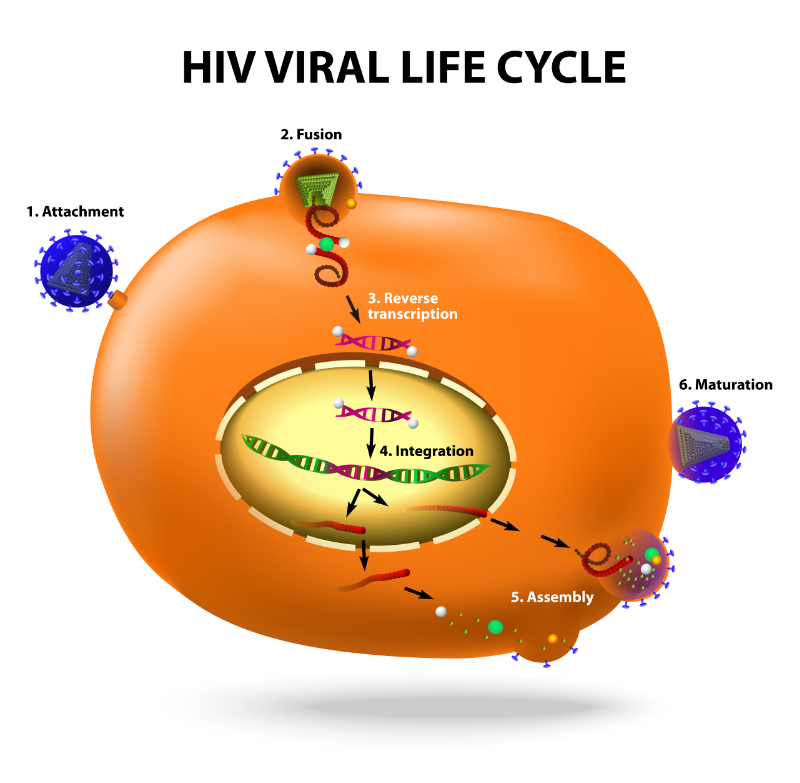Chronic HIV infection leads to AIDS in cases of a failed ART regimen or inadequate provision of ART. At CD4 cell counts lower than 200 cells/mm3, AIDS is diagnosed. Knowing the patients' recent CD4 cell count helps the clinician understand the symptomatic presentation of this disease at every stage of progression. Particularly, HIV wasting syndrome helps clinicians better evaluate when a patient develops AIDS as a result of a failing therapy or poor ART adherence. Conditions that have been mostly reported at the AIDS stage of HIV infection include chronic HSV infection, Kaposi sarcoma, HIV encephalopathy, toxoplasmosis, orolabial manifestation of HSV, leukocytopenia, pneumonia, and extrapulmonary cryptococcosis.
AIDS significantly increases the risk of cardiovascular impairment in HIV-positive patients. Symptoms commonly presented in this regard include chest pain, fatigue, dyspnea, and unexplained palpitations (Choi et al., 2021). Clinicians can assess HIV-related cardiovascular complications by examining the jugular veins for distension, checking for peripheral edema, listening to heart murmurs, and checking for signs of pulmonary edema. In most cases, the presenting cardiovascular symptoms in AIDS patients include muffled heart sounds, heart murmurs, pericarditis, point distensions of the jugular veins, and cardiac tamponade secondary to a Mycobacterium tuberculosis infection.
In the pulmonary system, the clinical presentation of AIDS directly influences the rate and manner of airflow. A compromised immune system alters the biological defense of the pulmonary architecture, exposing the upper and lower respiratory tracts to opportunistic infections. Upper respiratory tract infections and bronchitis are the most reported pulmonary complications in these patients. Others of varied levels of expression in the AIDS patient population may include lung cancer, non-Hodgkin's sarcoma, Kaposi sarcoma, sarcoidosis, and emphysema. Clinical evaluations of these symptoms should be prioritized and scheduled daily. Clinicians may assess tripoding, posturing, and other signs of respiratory distress, cyanosis, and tachypnea. Focal adventitious lung sounds may be diagnosed using proper auscultation techniques.
AIDS-related symptoms of the gastrointestinal tract are secondary to opportunistic infections, biological complications, and adverse effects of ART. Lower CD4 counts have been linked to increased susceptibility of the hepatobiliary system, altering normal digestion and upsetting the mechanics of enzyme secretion and action. In addition to this, the daily dosage regimen of ART medications may cause multiple side effects, including steatosis, pancreatitis, and hepatotoxicity (Verma et al., 2022). Other commonly diagnosed gastrointestinal complications of AIDS include esophagitis, herpes simplex infection, and frequent, unexplained bouts of diarrhea secondary to Cryptosporidium infection.
In the central nervous system (CNS), AIDS complications directly impair memory, cognition, and social functioning. Meningitis, cerebral malignancies secondary to immunosuppression, and focal demyelinating lesions are the most commonly presented CNS complications of AIDS (Zenebe et al., 2022).
Depending on the recent CD4 cell count, complaints, as presented, may include frequent headaches, seizures, migraines, cognitive disability, slurred speech, and visual impairments. To properly track symptom development or response to additional symptomatic therapy, clinicians may document the time of symptom onset, severity scale, symptoms' daily frequency, and associated disorders. Reports can also include symptom details on other common CNS presentations, including fevers, neck pain, and any signs of neurologic impairment. Maculopapular rash, morbilliform rash, and oral ulcers are the common symptoms of the dermatologic system in AIDS infection. Others include Kaposi sarcoma, nodules, and vascular neoplasm. In severely immunocompromised patients, dermatologic dissemination of fungal skin infections may also be observed. Clinical observations of dermatological manifestation should prioritize inquiries such as the onset of symptoms, recent skin infections, medical history, allergy profile, and ART side effects (Ramaswami et al., 2021).










